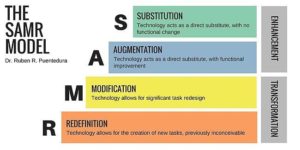Wow, the last week of the semester! I can’t believe it has gone by so fast.
We’ve learned a whole lot about theories in this program so far. Theories of psychology, theories of classroom management and theories of technology use. In our multiliteracies class, we talked a bit about technology use in the classroom and how much was too much. We also discussed the idea of technology and whether or not it can replace the teacher – the consensus on that was no! If not for the sake that we want to actually work our jobs as teachers, but technology cannot offer the same things that a teacher can. Although technology can be amazing and very helpful for students, it is not a replacement for teachers. Technology cannot have the same emotional connections and relationships that humans, especially teachers provide. We looked at the example of Milo, who is a little robot guy that helps in the classroom, specifically with children who have special needs such as autism. It has been seen that Milo can provide emotional and relational support – so are our claims that technology is not a replacement false?
In the meantime, while the statement is discussed of whether or not teachers can be replaced. Let’s talk a bit about the best way to integrate tech into the classroom. As I’ve learned throughout this program so far, technology is daunting and can be very overwhelming. The SAMR model (Substitution, Augmentation, Modification, Redefinition) is a good model for introducing technology into the classroom. There isn’t much of a point using technology just for the sake of using technology. It becomes beneficial when it adds to a lesson or makes the lesson more engaging.

Another interesting thing about technology is the ability to have access to a lot of information and resources. For example, the ability for students to access information on topics and to easily do research as opposed to spending hours at the library combing through the stacks. Of course, “accessibility” is different for every person. It may be easier for someone to go to the library than research on the internet. The open resources of information however, is amazing. Open education is very important to increase accessibility of information. Having openly available textbooks and news sources (among others) create these spaces where learning can become infinite. Having textbooks or news sites behind a pay wall does nothing to inform people and makes learning even harder. In a time where technology and the internet is at the forefront of everything we do, why would we have all this information not accessible to everyone and anyone?





